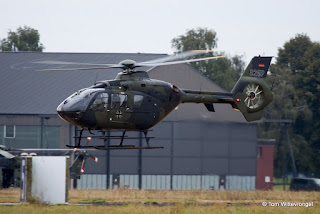Bückeburg Air Base is located northeast of the city of Bückeburg, Lower Saxony, Germany. The airfield was built in 1946 as a RAF Station, RAF Bückeburg, serving the headquarters of the Royal Air Force Germany in Bad Eilsen. It complemented the nearby headquarters of the British Army of the Rhine in Bad Oeynhausen. During the Berlin Airlift it was one of the numerous air fields from where supply flights to Berlin were carried out. After the building of the British Forces' Joint Headquarters (JHQ) at Rheindahlen in 1954, the RAF closed the airfield at the end of the 1950s.
With the foundation of the Bundeswehr in 1955, a decision was made that every branch of the Bundeswehr should have their own helicopter units, operating within the framework of the tasks designated to each branch of the armed forces. Thus, the German Army Aviation Corps was founded. The first training school, of this newly established branch of the German Army, the School of Army Aviation, was established in 1959 in Mendig but moved to its current location in Bückeburg in January 1960 and has been there ever since.
Bückeburg Air Base is used by the German Army's School of Army Aviation as one of the bases for the practical instruction of its flying and non-flying personnel. Basic flying training of helicopter pilots of other components of the German Armed Forces also takes place at Bückeburg Air Base.
Apart from the actual flight training, modern high-end flight simulators are extensively used during the training of future military helicopter pilots.
Approximately 70 helicopters are permanently based at the airfield, 30 of which are used on a daily base for training. Initial training begins with the Eurocopter EC 135. During the second stage, prospective pilots are then instructed in flying the Bell UH-1D, medium transport helicopters NH90 and Sikorsky CH-53G/GS.
The tasks of Army Aviators Test Squadron 910 consist not only of trials of new types of helicopters but also of tactical and logistical research aiming at improving and developing the efficiency and concepts under which the German Army Aviators Corps are supposed to fulfil their manifolds tasks.
With the foundation of the Bundeswehr in 1955, a decision was made that every branch of the Bundeswehr should have their own helicopter units, operating within the framework of the tasks designated to each branch of the armed forces. Thus, the German Army Aviation Corps was founded. The first training school, of this newly established branch of the German Army, the School of Army Aviation, was established in 1959 in Mendig but moved to its current location in Bückeburg in January 1960 and has been there ever since.
Bückeburg Air Base is used by the German Army's School of Army Aviation as one of the bases for the practical instruction of its flying and non-flying personnel. Basic flying training of helicopter pilots of other components of the German Armed Forces also takes place at Bückeburg Air Base.
Apart from the actual flight training, modern high-end flight simulators are extensively used during the training of future military helicopter pilots.
Approximately 70 helicopters are permanently based at the airfield, 30 of which are used on a daily base for training. Initial training begins with the Eurocopter EC 135. During the second stage, prospective pilots are then instructed in flying the Bell UH-1D, medium transport helicopters NH90 and Sikorsky CH-53G/GS.
The tasks of Army Aviators Test Squadron 910 consist not only of trials of new types of helicopters but also of tactical and logistical research aiming at improving and developing the efficiency and concepts under which the German Army Aviators Corps are supposed to fulfil their manifolds tasks.
 |
| EC35T1 German Army 82+59 |
 |
| NH90-TTH German Army 78+27 |
 |
| EC135T1 German Army 82+54 |
 |
| EC135T1 German Army 82+54 |

No comments:
Post a Comment